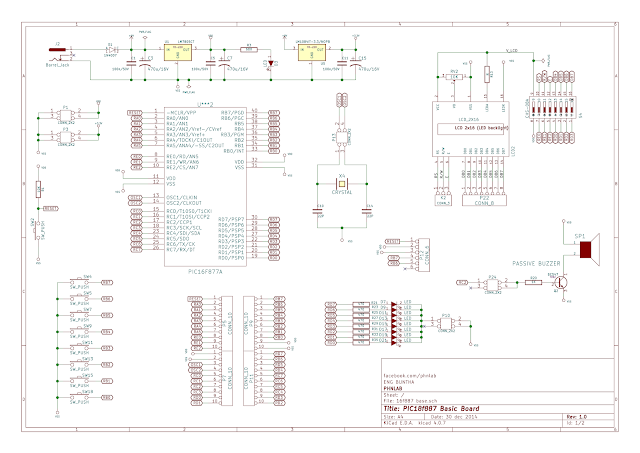Overview
I started learning to program the PIC micro-controller using the free and open source tutorials on the webs. With these study and experimental experiences I decided to make my own development by myself.I have some electronic components in stock and some in-house PCB processing materials. This board is designed to fit the popular PIC16F877A or PIC16F887.
PIC is one of the most popular micro-controller. There are many available development boards with sample source code.
 |
| A completed assembling project. PIC16F877A placed on board. The test program shows the ADC reading from four inputs analog channel. |
Printed Circuit Board Design And Assembling
The PCB is made using a DIY in-house silk screen process. I made a few of these board for my own use.
This PCB project is designed using KiCAD EDA. It's free and open source with many shared component libraries available online.
These available on-board blocks:
- A 12 V input with a 5 V DC regulated supply to the micro-controller and other devices.
- A RS-232 to TTL level converter
- A 40-pin ZIF socket that could fit many 8-bit PIC devices.
- A on-board I2C devices block, ds1307 and EEPROM
- A character LCD module
- LED and multiplexed display
- Tactile switches connect to PORTB
 |
| Main Sheet Of The Schematic |
 |
| Secondary Sheet Of The Schematic |
 |
| Components Side |
 |
| Solder Side |
You can create your own by using a simple tone transfer method. The project file could be download here.
Image Galleries
MikroC Tutorials
- Blinking The PIC16F877A With MikroC
- Reading Digital Inputs From PortB With PortD Outputs Of PIC16F877A With MikroC
MPLAB X IDE and XC8 Tutorials
I/O PORT Programming
- PIC16F877A XC8 PortD Blink
- PIC16F877A HD44780 LCD in 4-Bit Mode XC8
- PIC16F877A Port B Interrupt XC8 Example
- PIC16F877A XC8 Multiplex Display Example
TIMER0 Programming
Analog to Digital Converter (ADC) Programming
- PIC16F877A Analog to Digital Converter XC8 Example
- PIC16F877A ADC Simple 5V DVM XC8 Example
- PIC16F877A ADC and LCD XC8 Example
- PIC16F877A LM35 Temperature Sensor XC8 Example
Inter Integrated Circuit (I2C) Programming
- PIC16F877A I2C and DS1307 Real Time Clock Example
- PIC16F877A 24C16 I2C EEPROM LCD Example
- PIC16F877A I2C PCF8574AP Reading XC8 Example
- PIC16F877A PCF8574 I2C Character LCD XC8 Example
- PIC16F877A PCF8574AP I2C 4x4 Matrix KeyPad XC8 Example
- PIC16F877A MCP23017 I2C GPIO Expanding XC8 Example
- PIC16F877A MCP23017 I2C LCD XC8 Example
- PIC16F877A MCP23017 LCD and KeyPad XC8 Example
- PIC16F877A SH1106 I2C OLED Display XC8 Example




No comments:
Post a Comment